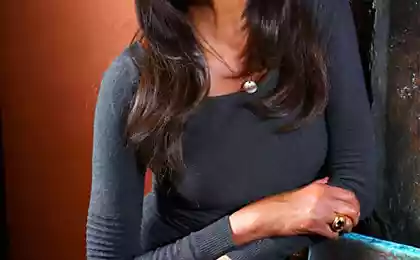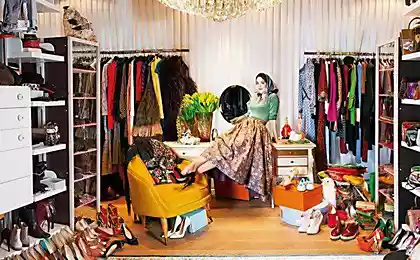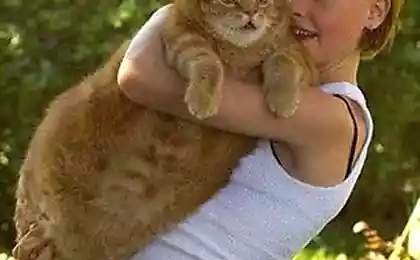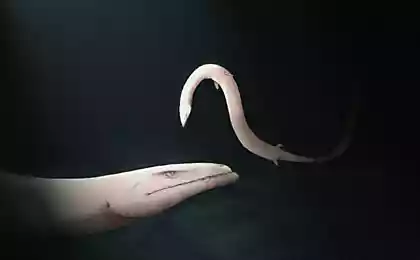658
Animals. New? Older?
7 prints
In 1819, the great Cuvier said that the vertebrate fauna is studied thoroughly, and further suggested that reports of new species consider to be fake. Since then, the open forest elephant, okapi, fusiform antelope, mountain gorilla ... and a dozen species, including the famous lobe-finned fish, in ancient times gave rise to tetrapods. On it showed a paleontological data - and here it turned out that one of the species of lobe-finned fish live so far!
Whom are humanity "discovered" after 1819? Who "lost»?
1) coelacanth. It was long thought that the coelacanth became extinct a long time ago - 200-300 million years ago (according to other sources - about 70 million years ago). However, in 1938, he was found alive at the Comoros. But the sources did not enjoy the special confidence. Therefore, this famous fish - it is closest to the four-legged view from the living - to continue to be considered extinct. But in the 1990s the fish was caught off the coast of South Africa. Recently, when the scientific quest it is quite common off the coast of South Africa and Mozambique, at a depth of several hundred meters. Moreover, fish has not changed much over many millions of years. The structure of the skeleton of a modern coelacanth almost identical skeleton ancestors lived 200 million years ago (though the average size of a little more modern).
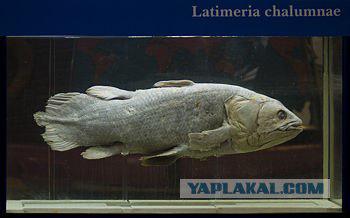
2) Dugong. The smallest representative of the order Sirenia: the length of the body 2, 5-4 m, weight up to 600 kg. The maximum recorded length of the body (male caught in the Red Sea) was 5, 8 m. Pronounced sexual dimorphism: males are larger than females. Currently, the largest population of dugongs (more than 10 000 individuals) lives at the Great Barrier Reef and the Torres Strait. Large populations off the coast of Kenya and Mozambique strongly reduced after 1970. Off the coast of Tanzania, the last instance of dugong watching January 22, 2003, after 70-year break. A small number of dugongs is found at the Palau (Micronesia), have about. Okinawa (Japan), and in Johor Strait between Malaysia and Singapore.

3) placoderms. This class gnathostomatous (Gnasthostomata), who lived in the Paleozoic, from the early Silurian. The heyday of armored fishes fell on Devon, but at the end of his class of fish completely died out. The early armored fish live exclusively in fresh water, but later they moved in the sea. Recently, however, ichthyologists are inclined to think that some of placoderms (Bothriolepis panderi) somehow survived.

4) Steller's sea cow. Important role in the disappearance of sea cow has played its excessive greed for food. These voracious animals ate constantly, forcing them to hold his head under water. Safety and caution were unknown cows Steller, and fishermen used gullibility and unconcern of mammals - could just float between them on the boat and choose a suitable victim. Steller's sea cow. Manatees paid dearly for his philanthropy - after twenty-seven years after the opening of the form had been killed the last of the members of these wonderful animals. In 1768 Steller's sea cow disappeared from the face of the earth, and Georg Steller was the only naturalist who saw these glorious mammals living and left a detailed description of the species. But !!! Found ... And immediately lost ... Although foty left. Though they say that the dugong ... Fuck them will deal ...

5) Okapi. Type of cloven-hoofed animals from the family giraffidae. By its build of body okapi at first glance more like a horse than a giraffe, moreover, they are behind bars, like a zebra. Nevertheless, from zebra Okapi quite far, being in a completely different party. At the okapi velvety chocolate-colored wool, which plays a reddish tinge. Limbs white or light brown, black and white face coloring. It lives only in the Congo. Raskaz in Europe and America about this animal was carried out very much, but ... No one has seen, and photos - no ... It was only in 1909, the white man managed to catch a live okapi.

6) Kraken. Based on the above description Potoppidanom, Carl Linnaeus classified the Kraken, among other cephalopods and awarded him the Latin name Microcosmus. However, from the second edition of his «Systema Naturae» Krakow was excluded. In 1802, the French zoologist Pierre-Denis de Montfort published a study of mollusks, which proposed to distinguish between two kinds of mysterious animal - kraken octopus, inhabiting the northern seas and the first supposedly described by Pliny the Elder, and a giant octopus, which terrifies the ships plowing open spaces Southern Hemisphere. Academic community reacted to the critical reasoning Montfort. Skeptics believe that the evidence of the Kraken sailors can be explained by an underwater volcanic activity off the coast of Iceland, which manifests itself in bubbles coming out of the water, sudden and very dangerous currents change, appearance and disappearance of new islets. Only in 1857 it was proved the existence of giant squid (Architeuthis dux).
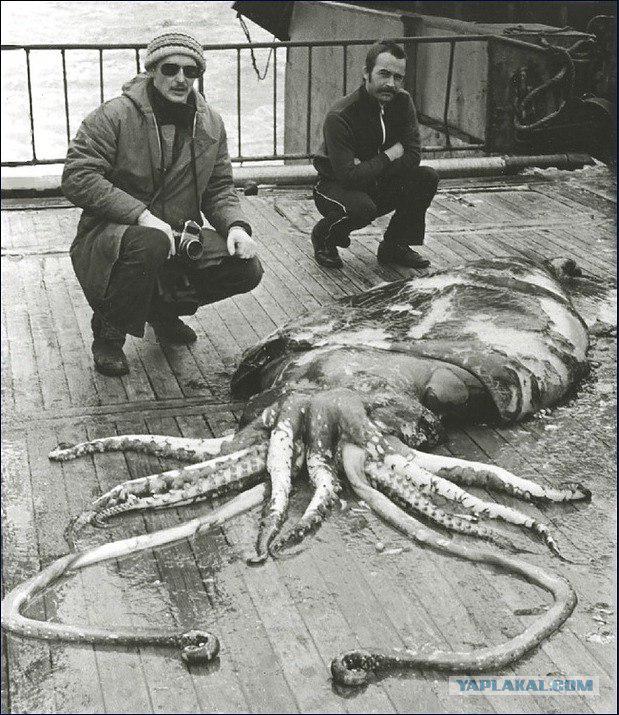
7) So far in our country alive and people who assure scientists that they saw and chased live mammoth. Scientists, of course, do not believe. But .... Location Siberian hunters know what the scientists themselves, then recently realized? Question without an answer ...
You ask where I naryl all this? Yes, from the book by Bernard Eyvelmansa "Secrets of the mysterious beasts." This is not advertising the book you should buy. It can be simply read. Here. Link. From heart comes off straight, toad strangling .... Just read it, put back on the shelf? Lada ??? (... What if mammoths were still alive, and?)
www.smoliy.ru/lib/000/001/00000102/...nih_zverey0.htm
forest elephant, fusiform antelope, mountain gorilla - that these have not yet outlined ... Well, okay ...

Source:
In 1819, the great Cuvier said that the vertebrate fauna is studied thoroughly, and further suggested that reports of new species consider to be fake. Since then, the open forest elephant, okapi, fusiform antelope, mountain gorilla ... and a dozen species, including the famous lobe-finned fish, in ancient times gave rise to tetrapods. On it showed a paleontological data - and here it turned out that one of the species of lobe-finned fish live so far!
Whom are humanity "discovered" after 1819? Who "lost»?
1) coelacanth. It was long thought that the coelacanth became extinct a long time ago - 200-300 million years ago (according to other sources - about 70 million years ago). However, in 1938, he was found alive at the Comoros. But the sources did not enjoy the special confidence. Therefore, this famous fish - it is closest to the four-legged view from the living - to continue to be considered extinct. But in the 1990s the fish was caught off the coast of South Africa. Recently, when the scientific quest it is quite common off the coast of South Africa and Mozambique, at a depth of several hundred meters. Moreover, fish has not changed much over many millions of years. The structure of the skeleton of a modern coelacanth almost identical skeleton ancestors lived 200 million years ago (though the average size of a little more modern).

2) Dugong. The smallest representative of the order Sirenia: the length of the body 2, 5-4 m, weight up to 600 kg. The maximum recorded length of the body (male caught in the Red Sea) was 5, 8 m. Pronounced sexual dimorphism: males are larger than females. Currently, the largest population of dugongs (more than 10 000 individuals) lives at the Great Barrier Reef and the Torres Strait. Large populations off the coast of Kenya and Mozambique strongly reduced after 1970. Off the coast of Tanzania, the last instance of dugong watching January 22, 2003, after 70-year break. A small number of dugongs is found at the Palau (Micronesia), have about. Okinawa (Japan), and in Johor Strait between Malaysia and Singapore.

3) placoderms. This class gnathostomatous (Gnasthostomata), who lived in the Paleozoic, from the early Silurian. The heyday of armored fishes fell on Devon, but at the end of his class of fish completely died out. The early armored fish live exclusively in fresh water, but later they moved in the sea. Recently, however, ichthyologists are inclined to think that some of placoderms (Bothriolepis panderi) somehow survived.

4) Steller's sea cow. Important role in the disappearance of sea cow has played its excessive greed for food. These voracious animals ate constantly, forcing them to hold his head under water. Safety and caution were unknown cows Steller, and fishermen used gullibility and unconcern of mammals - could just float between them on the boat and choose a suitable victim. Steller's sea cow. Manatees paid dearly for his philanthropy - after twenty-seven years after the opening of the form had been killed the last of the members of these wonderful animals. In 1768 Steller's sea cow disappeared from the face of the earth, and Georg Steller was the only naturalist who saw these glorious mammals living and left a detailed description of the species. But !!! Found ... And immediately lost ... Although foty left. Though they say that the dugong ... Fuck them will deal ...

5) Okapi. Type of cloven-hoofed animals from the family giraffidae. By its build of body okapi at first glance more like a horse than a giraffe, moreover, they are behind bars, like a zebra. Nevertheless, from zebra Okapi quite far, being in a completely different party. At the okapi velvety chocolate-colored wool, which plays a reddish tinge. Limbs white or light brown, black and white face coloring. It lives only in the Congo. Raskaz in Europe and America about this animal was carried out very much, but ... No one has seen, and photos - no ... It was only in 1909, the white man managed to catch a live okapi.

6) Kraken. Based on the above description Potoppidanom, Carl Linnaeus classified the Kraken, among other cephalopods and awarded him the Latin name Microcosmus. However, from the second edition of his «Systema Naturae» Krakow was excluded. In 1802, the French zoologist Pierre-Denis de Montfort published a study of mollusks, which proposed to distinguish between two kinds of mysterious animal - kraken octopus, inhabiting the northern seas and the first supposedly described by Pliny the Elder, and a giant octopus, which terrifies the ships plowing open spaces Southern Hemisphere. Academic community reacted to the critical reasoning Montfort. Skeptics believe that the evidence of the Kraken sailors can be explained by an underwater volcanic activity off the coast of Iceland, which manifests itself in bubbles coming out of the water, sudden and very dangerous currents change, appearance and disappearance of new islets. Only in 1857 it was proved the existence of giant squid (Architeuthis dux).

7) So far in our country alive and people who assure scientists that they saw and chased live mammoth. Scientists, of course, do not believe. But .... Location Siberian hunters know what the scientists themselves, then recently realized? Question without an answer ...
You ask where I naryl all this? Yes, from the book by Bernard Eyvelmansa "Secrets of the mysterious beasts." This is not advertising the book you should buy. It can be simply read. Here. Link. From heart comes off straight, toad strangling .... Just read it, put back on the shelf? Lada ??? (... What if mammoths were still alive, and?)
www.smoliy.ru/lib/000/001/00000102/...nih_zverey0.htm
forest elephant, fusiform antelope, mountain gorilla - that these have not yet outlined ... Well, okay ...

Source:
